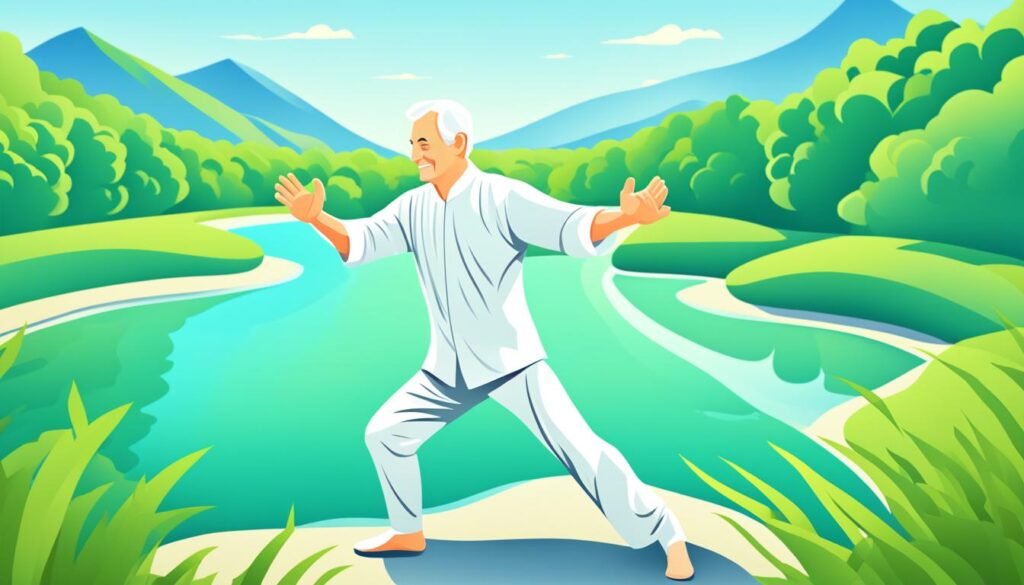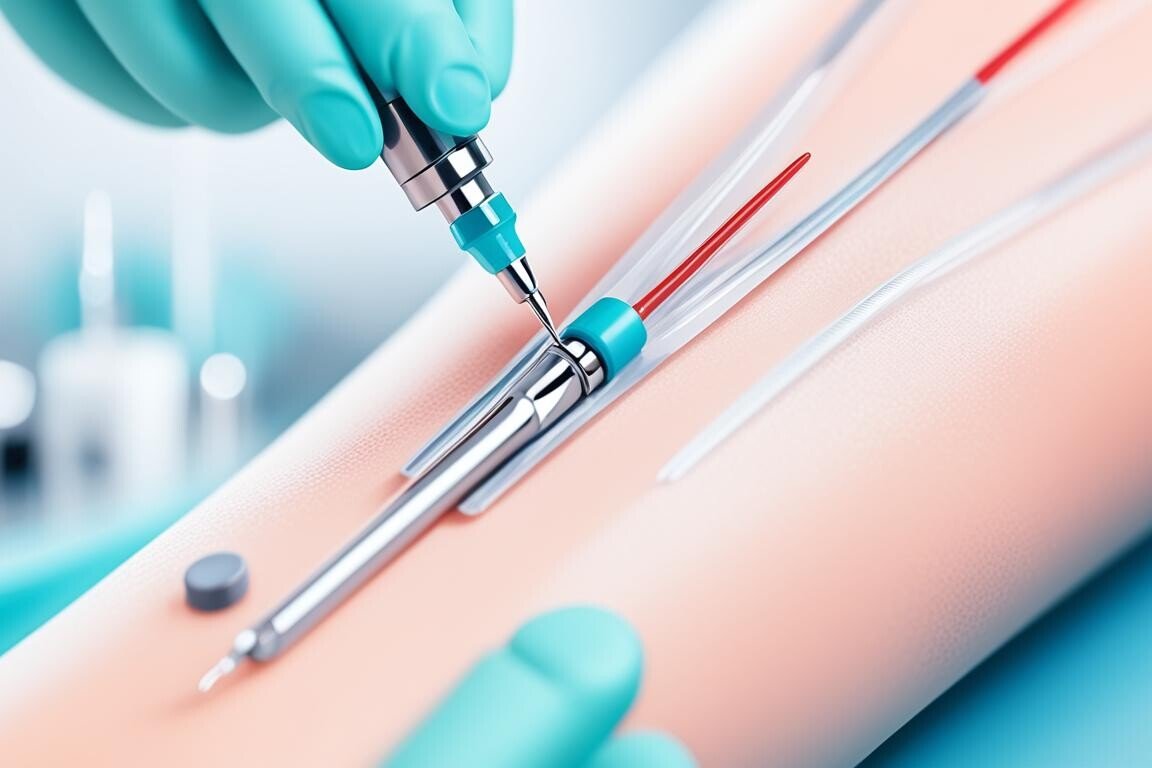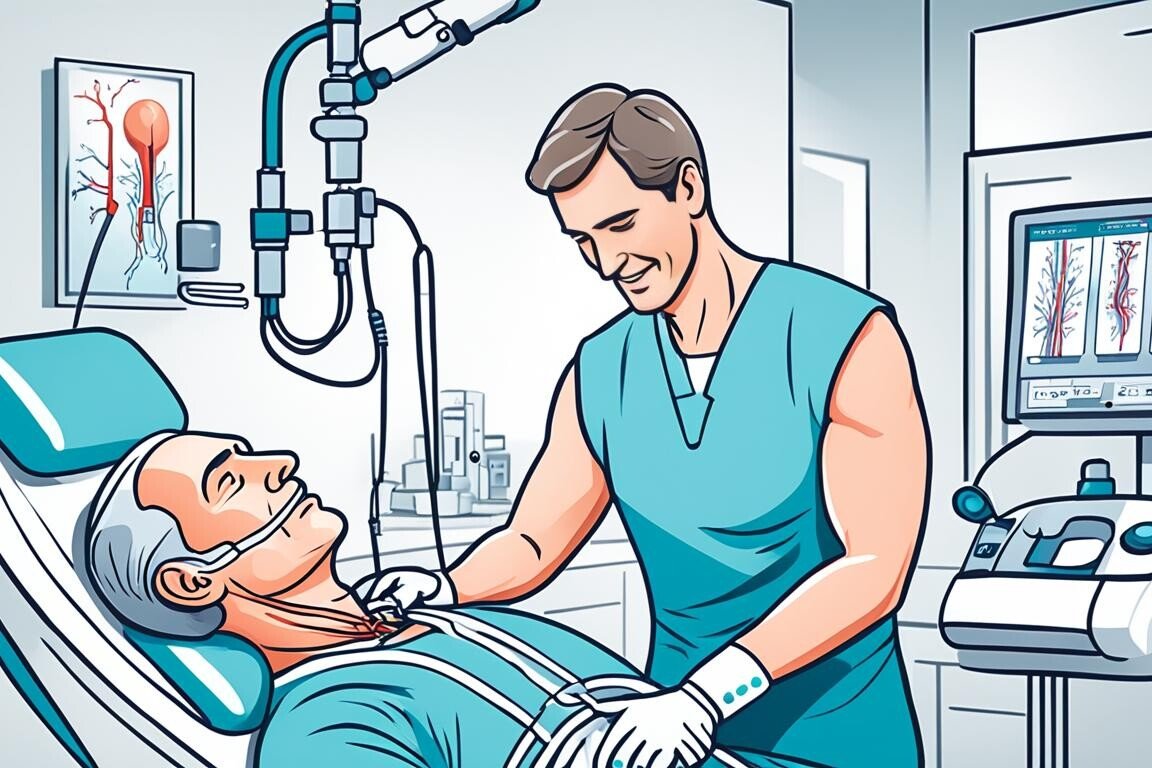Knee pain is a common issue that can often be managed at home. This article will show you natural and easy ways to ease your knee pain. Whether it’s mild, moderate, or severe, you’ll find ways to help yourself without seeing a doctor.
You’ll learn about simple RICE (Rest, Ice, Compression, Elevation) methods and exercises. You’ll also discover herbal treatments to help you move better and lessen pain at home.
Knee pain can come from many things like arthritis, overuse, injury, and lifestyle choices. By knowing what causes your pain and using the right methods, you can ease your discomfort and avoid more problems. Let’s look at home remedies and strategies to help your knee pain and boost your joint health.
Table of Contents
ToggleAssess Your Knee Pain
The first step in addressing knee pain at home is to assess the severity of your condition. Understanding the nature and extent of your knee discomfort can help you determine the most appropriate treatment approach.
Mild to Moderate Pain
If you have mild to moderate knee pain, it might be from a sprain, strain, or arthritis. Home remedies can help manage these symptoms. You might notice some swelling, tenderness, or difficulty moving.
In such cases, self-care like the RICE (Rest, Ice, Compression, Elevation) method can offer relief.
Severe or Persistent Pain
But, if the pain is severe or doesn’t go away, you should see a doctor. Severe pain, visible deformity, or signs of infection like redness and warmth need professional help. Tests like X-rays, MRI, or CT scans might be needed to find out what’s causing the pain.
Remember, seeing a healthcare professional is key if your knee pain is swollen, unstable, or makes moving hard. Getting the right assessment and treatment early can stop things from getting worse and help you recover faster.

It’s important to talk to a healthcare professional, especially if your knee pain is swollen, unstable, or makes moving hard. Proper assessment and timely treatment can help prevent the condition from getting worse and ensure a speedy recovery.
Try RICE for Strains and Sprains
The RICE method is a great way to treat knee pain at home. It stands for Rest, Ice, Compression, and Elevation. It’s especially good for knee strains and sprains. Start by resting the knee and avoiding hard activities.
Use ice packs on the knee for 15-20 minutes, several times a day. This helps reduce swelling and inflammation. Then, wrap the knee with a compression bandage for support. Elevate the leg above your heart level to lessen swelling.
Following the RICE method can help minor knee injuries heal faster.
Gabe Mirkin, MD, introduced the RICE method in 1978 for sports injuries. In 2015, he updated his advice. He said ice doesn’t speed up healing, and too much rest can slow it down.
The RICE method is good for minor injuries like sprains, jammed fingers, and knee injuries. Use it for the first 1-3 days after an injury. If pain and swelling don’t go away after 5-7 days, see a doctor.
- Apply ice for 15-20 minutes every 2-3 hours during the first 24-48 hours to reduce swelling.
- Wear appropriate shoes, take breaks, stretch, and stay in good condition to prevent knee injuries.
- NSAIDs and acetaminophen can be recommended along with RICE for pain management, with caution over prolonged use.
Don’t use the RICE method for serious injuries like organ breaks, dislocated joints, or broken bones. It’s a good way to treat managing knee joint injuries and reducing knee inflammation from knee sprains.

Tai Chi for Osteoarthritis
If you’re one of the millions dealing with knee osteoarthritis, tai chi might be a solution. Tai chi has been shown to lessen pain and boost knee movement. It’s a great way to handle the symptoms of this common issue.
Tai chi is all about slow, flowing movements, deep breathing, and meditation. It’s a mind-body exercise that enhances balance, flexibility, and joint health. The American College of Rheumatology and Arthritis Foundation suggest tai chi for knee osteoarthritis.
A study at Texas Tech University found tai chi helped adults with knee osteoarthritis. They had less pain and better physical function after six weeks. Another study with 152 older adults saw moderate improvements in physical function after 12 weeks of tai chi and water exercises.
Tai chi aims to balance life energy (“qi”) and aids in healing by restoring this balance. It leads to better balance, flexibility, and muscle strength. It’s best to learn from an instructor to get the right posture and breathing. Classes are available in Arthritis Foundation chapters and fitness centers.

Looking for a natural way to ease your knee osteoarthritis? Try tai chi. This exercise improves knee flexibility and balance. It also offers pain relief and benefits for joint health.
Exercise for Knee Strength
Keeping your knee muscles strong and flexible is key to handling knee pain and boosting joint health. Adding low-impact activities and exercises that strengthen muscles can help ease pain and stop future issues.
Low-Impact Activities
Walking, cycling, swimming, and water aerobics are easy on the knees but still good for your heart. They help keep the joint moving and flexible without too much stress.
Muscle-Strengthening Exercises
Strengthening muscles around the knee, like the quadriceps, gives better support and less strain on the joint. Doing exercises like leg raises, step-ups, and controlled squats can build strength and stability.
It’s smart to work with a physical therapist or healthcare provider to create an exercise plan that fits you. They can teach you the right way to do exercises safely and effectively.

Combining low-impact activities with muscle-strengthening exercises can make your knees more mobile, stable, and less painful.
Weight Management for Reduced Pressure
Carrying extra weight puts more pressure on your knee joints, making pain and inflammation worse. The Arthritis Foundation says extra weight can add 15-50 pounds of pressure on your knees. Losing weight through diet and exercise can ease the strain on your knee joints, especially if you have osteoarthritis.
Eating well and doing low-impact exercises can help you lose weight and lower the risk of more joint damage and pain. Here are some tips:
- Try losing weight slowly, about 2 pounds a month, for better knee function and less inflammation.
- Add activities like walking, cycling, water exercises, and strength training to your routine.
- Use a walking aid like a crutch or cane to ease the stress on your knee during everyday tasks.
Even small weight changes can greatly reduce knee joint pressure and help with osteoarthritis. Focusing on weight management is a big step towards easing knee pain and improving your life quality.
Heat and Cold Therapy
Using both heat and cold can help ease knee pain at home. Heat and cold therapies have different benefits for knee health. They help with mobility and reduce swelling.
Applying Heat
Heat, like a heating pad or warm bath, relaxes muscles and boosts circulation. It makes joints more flexible. This is great for chronic knee issues like osteoarthritis. Heat also helps with muscle pain, spasms, and stiffness.
Apply heat for up to 20 minutes, several times a day. This brings more blood, oxygen, and nutrients to the knee. It helps with healing and eases pain. But, be careful not to touch your skin directly with extreme heat to avoid burns.
Applying Cold
Cold therapy, such as ice packs or cold compresses, reduces swelling and inflammation. It’s good for sudden knee injuries like sprains or strains. Cold slows blood flow to lessen pain and prevent more damage.
Use cold packs for 20 minutes, several times a day, in the first 48 hours after an injury. You can use a bag of frozen peas, ice in a towel, or cold gel packs. Just don’t put ice directly on your skin to avoid frostbite.
Mixing heat and cold therapy, or contrast therapy, is good for chronic conditions like arthritis. It alternates heat and cold to improve flexibility, motion, and lessen pain.
If knee pain gets worse, with more swelling, instability, or after an injury, see a healthcare professional. They can offer personalized advice and help heal your knee faster.
Herbal Ointments and Salves
Some herbal ointments and salves can help with knee pain. A study showed a salve with cinnamon, ginger, mastic, and sesame oil worked as well as over-the-counter creams. Herbs like willow bark, which has compounds like aspirin, may also help with anti-inflammatory properties. These topical ointments for knee relief could be useful for managing knee pain.
But, always talk to a healthcare provider before trying herbal remedies for knee pain. Some herbs might not mix well with your medicines or could have bad effects. Always be careful and listen to your doctor when using natural anti-inflammatory treatments.
- A 2019 review noted that boswellic acid appears to have anti-inflammatory effects that could help people with RA, bronchial asthma, ulcerative colitis, and other inflammatory diseases.
- A small, older study from 2002 showed that cat’s claw was effective in reducing joint swelling by over 50% in 40 people with RA.
- Researchers have found evidence that extracts or specific components of green tea may affect arthritis, but more research is needed to determine the most effective form and dose.
Be careful with ginger, as it can affect some medicines like warfarin (Coumadin), a blood thinner. Also, the FDA doesn’t check natural remedies like thunder god vine, and the wrong part can be toxic.
Before trying herbal remedies for arthritis, talk to a doctor. Some options might not work well with your current medicines. With a doctor’s advice, herbal ointments and salves can be a great part of your knee pain plan.
Ginger Extract for Pain Relief
If you’re dealing with knee pain, ginger might help. It has natural anti-inflammatory properties. Studies show ginger extract can ease knee osteoarthritis symptoms.
In a study with 67 people with osteoarthritis, ginger and ibuprofen reduced pain more than a placebo. Another trial with 29 people found ginger lowered pain and disability from the disease more than a placebo.
Ginger is a good option for those looking for natural pain relief. You can take it as supplements, tea, or add it to food. Studies suggest taking 510–1,000 mg of ginger daily for musculoskeletal issues.
More research is needed, but ginger’s anti-inflammatory effects look promising for ginger for knee pain and supplemental treatments for knee osteoarthritis. Adding ginger to your treatment plan might help ease knee osteoarthritis symptoms. It’s a natural way to fight inflammation.
Knee Pain Treatment At Home
There are many home remedies and natural solutions for knee pain. These go beyond what we’ve talked about already. Trying a few more techniques might help you feel better.
Keeping a good posture and using things like knee braces or crutches can ease the stress on your knees. Massaging your thigh muscles can also help. It relaxes the muscles and boosts blood flow in the area.
Adding an Epsom salt bath to your routine might also help. The magnesium in the salts can relax your muscles and lessen inflammation. This could make your knee pain better.
If your knee pain doesn’t get better or gets worse, see a healthcare professional. They can give you advice tailored to your needs and check if you need more treatment.
Using natural ways to ease knee pain and taking good care of yourself can help a lot. Always pay attention to your body. And don’t wait to get help from a professional if the pain is too much.
Posture and Knee Support
Keeping the right posture for knee health and using supports can help ease knee pain. Don’t sit in low chairs or couches that make you sink in. This can strain your knees. Use a pillow or a raised surface to keep your knees at a comfy level when sitting.
Wearing shoes with good arch support can also ease pressure on the knee joints. If needed, consider knee braces or sleeves for extra stability and protection. These can lessen stress on your knees, especially during activities that might strain them.
Avoid activities that put too much strain on your knees, like high-impact exercises or standing or sitting for too long. Choose low-impact activities like walking, swimming, or cycling to stay fit without making your knee pain worse.
By keeping good posture, using supports, and being careful with your activities, you can help manage and maybe even lessen your knee pain. Remember, fixing the main cause is crucial for lasting relief.
Dietary Measures and Weight Loss
Your diet and weight management are key to easing knee pain, especially with osteoarthritis. Carrying extra weight puts more pressure on your knee joints, making pain and inflammation worse. To help your joints, the Arthritis Foundation suggests a Mediterranean-style diet. This diet is full of fruits, veggies, whole grains, and healthy fats.
Mediterranean Diet
This diet is balanced and fights inflammation. It helps you keep a healthy weight and gives your joints the nutrients they need. Losing weight with diet and exercise can also ease the load on your knees and lessen pain.
- People who eat fish high in omega-3s are less likely to get rheumatoid arthritis.
- Eating a 3-to-6 ounce serving of fish at least four times a week can cut down on osteoarthritis inflammation and protect your heart.
- Low-fat dairy products can be good for people with osteoarthritis of the knee.
- Studies show that people with osteoarthritis might have high cholesterol levels.
Eating a balanced diet with proteins from nuts, beans, eggs, lean meats, and fish helps your knee health. Add lots of fresh veggies, fruits, and whole grains to your meals. Mix this with walking or swimming for cardio and resistance exercises to strengthen your knee muscles. This approach can greatly improve your diet and knee pain management.
Medications for Pain Management
Home remedies can help with knee pain, but there are also medications that can offer relief. Over-the-counter NSAIDs like ibuprofen or naproxen can lessen inflammation and ease pain. Sometimes, doctors may suggest stronger options, such as topical treatments, steroid injections, or antidepressants like duloxetine, for chronic pain.
Always talk to a doctor before starting any new medication. This ensures safety and addresses the root cause of the pain. Misusing over-the-counter or prescription drugs can cause bad side effects. With a healthcare professional’s guidance, you can find the best over-the-counter medications for knee pain or prescription treatments for knee osteoarthritis to manage your pain.
Your doctor might suggest a mix of treatments, including physical therapy, weight management, and alternative therapies. The aim is to find the best way to manage knee discomfort with medication. This helps you move better and improve your quality of life.
Massage for Muscle Relaxation
Massage is a great way to ease knee pain by relaxing muscles and boosting blood flow. The American Massage Therapy Association suggests self-massage techniques for knee pain relief. These methods can help those struggling with knee issues.
One effective technique is to tap the thigh muscle above the knee, then slide your hand down to the knee. Gently pressing on the knee can also ease tension and enhance blood flow. These steps are great for easing knee stiffness and pain.
Massage isn’t a top choice for treating osteoarthritis, but it has many benefits. It can help manage stress, which is key for knee pain. Using essential oils like peppermint or eucalyptus during massage can make the experience even better.
Being consistent with massage is important for easing knee pain. Adding these techniques to your daily routine can help relax muscles and improve blood flow. This can lead to less pain over time.
Aromatherapy with Essential Oils
If you’re looking for natural ways to ease your knee pain, consider aromatherapy with essential oils. These oils contain aromatic compounds that might help with pain and inflammation in your knees.
Studies show that a mix of cinnamon, ginger, mastic, and sesame oil can ease pain and improve stiffness. The oils’ natural anti-inflammatory properties, like those found in ginger and orange, could be why.
Essential oils like lavender, eucalyptus, and lemongrass might also help with knee pain. For example, people with rheumatoid arthritis felt some pain relief after using lemongrass oil for a month. This is thanks to citral, a key component in lemongrass oil.
While more studies are needed, aromatherapy could be a good addition to home remedies for knee pain. Trying different essential oil blends or ways to apply them might help you find what works best for you.
Remember, use high-quality essential oils and mix them with a carrier oil before skin application. Always test a small area first to avoid skin reactions. With their natural anti-inflammatory properties, essential oils could be a soothing way to manage knee pain at home.
Conclusion
Knee pain can be a big problem, but you can tackle it with comprehensive home remedies for knee pain. These natural methods can help ease the pain and boost your knee health. Techniques like the RICE method, Tai Chi, and strengthening exercises are great starts.
Managing your weight and using heat or cold therapy can also help. Plus, herbal remedies offer another option. These methods can help you handle natural treatments for knee discomfort and keep your joints moving well.
If your knee pain doesn’t get better or gets worse, see a healthcare provider. But for many, the home remedies for knee pain mentioned here can really help. By changing your lifestyle and trying natural remedies, you can improve knee health without medical intervention. This can make your life better overall.
Being patient and balanced in your approach is crucial for lasting relief from knee pain. With the right strategies and a focus on your health, you can get your mobility back. And you can live a more active, pain-free life.
FAQ
What are some effective home remedies for knee pain?
For knee pain, try the RICE method (Rest, Ice, Compression, Elevation). Also, practice Tai Chi, do strengthening exercises, keep a healthy weight, use heat and cold therapy, and consider herbal remedies like ginger.
How can I assess the severity of my knee pain?
If your knee pain is mild to moderate, home remedies might help. This includes pain from sprains, strains, or arthritis. But, if the pain is severe or doesn’t go away, see a doctor for a full check-up.
What is the RICE method and how does it help with knee pain?
The RICE method stands for Rest, Ice, Compression, and Elevation. It’s great for treating knee strains and sprains. It cuts down swelling, reduces inflammation, and helps the knee heal.
How can Tai Chi help with knee osteoarthritis?
Tai Chi is a slow, flowing exercise. It has been shown to lessen pain and increase movement in the knee for people with osteoarthritis.
What types of exercises are recommended for knee pain?
Try low-impact activities like walking, cycling, swimming, and water aerobics. These can make the joint more mobile without putting too much stress on the knees. Also, strengthening the quadriceps can give better support and ease the knee’s burden.
How does weight management affect knee pain?
Carrying extra weight puts more pressure on the knee joints, making pain and inflammation worse. Losing weight through diet and more exercise can help ease the strain on the knees.
When should I use heat or cold therapy for knee pain?
Heat therapy can relax muscles and boost circulation. Cold therapy reduces swelling and inflammation. Use heat for up to 20 minutes, and cold packs for 20 minutes several times a day, especially in the first 48 hours after an injury.
Can herbal remedies and essential oils help with knee pain?
Yes, some herbal remedies and essential oils may help with knee pain. For example, topical ointments with cinnamon, ginger, and essential oils might have anti-inflammatory effects. But, always talk to a healthcare provider before trying these treatments.
How can ginger help with knee pain?
Ginger extract has anti-inflammatory properties. It might help manage knee osteoarthritis symptoms when used with other treatments.
What other home-based treatments can I try for knee pain?
For knee pain, also try good posture, supportive devices like braces or crutches, massage, and Epsom salt baths. These can help relax muscles and reduce inflammation.
Source Links
About The Author

This article is medically reviewed by Dr. Chandril Chugh, Board-Certified Neurologist, providing expert insights and reliable health information.
Dr. Chandril Chugh is a U.S.-trained neurologist with over a decade of experience. Known for his compassionate care, he specializes in treating neurological conditions such as migraines, epilepsy, and Parkinson’s disease. Dr. Chugh is highly regarded for his patient-centered approach and dedication to providing personalized care.
→ Book a consultation to discover which remedies suit your needs best.




